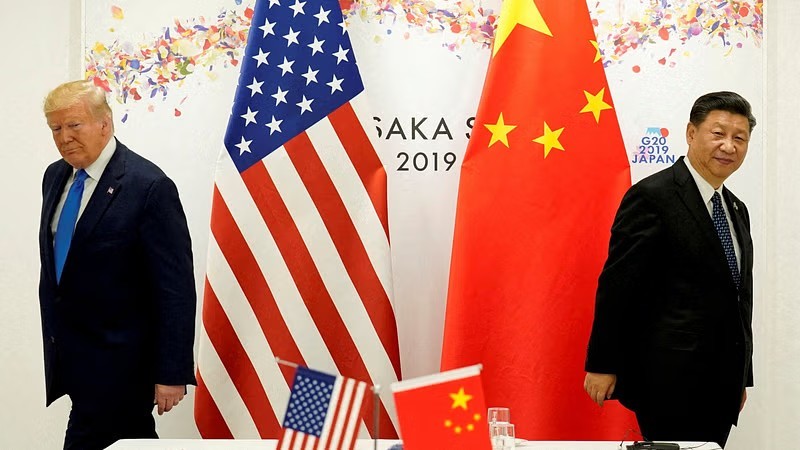China’s Strategic Response to Trump’s Trade War
Syllabus:
GS-2:
Effect of Policies & Politics of Countries on India’s Interests , International Treaties & Agreements , Government Policies & Interventions , India and its Neighbourhood , Important International Institutions
Focus:
Following the escalation of tariffs in the U.S.-China trade war, China’s defensive strategy of hedging risks, diversifying exports, and controlling the rare earth market has emerged as a strong counter to U.S. pressure, shifting global trade dynamics significantly.
Introduction: Trump’s Aggressive Trade Policy
- “America First” Policy: Launched by President Donald Trump, aiming to reduce the U.S. trade deficit.
- Weaponizing Trade: Trump used trade tariffs to extract concessions from trade partners, accusing them of unfair trade practices.
- Initial Target: China was one of the first countries to face retaliatory tariffs from the U.S.
- 90-Day Pause: On April 9, 2018, Trump delayed implementing reciprocal tariffs by 90 days for 57 countries, excluding China.
The U.S. Strategy: Tariffs as a Negotiating Tool
- Reciprocal Tariffs: Trump proposed tariffs on various countries to force negotiations and reduce trade deficits with the U.S.
- Pressure on Partners:S. intended to force trade partners into bilateral agreements for better terms.
- Targeted Strategy: The 90-day pause was meant to give Trump leverage to secure agreements, particularly with countries like China.
- Escalating Tariffs: As tensions rose, tariffs between the U.S. and China grew from 34% to 145% in response to China’s retaliations.
China’s Response: Retaliation and Strategic Hedging
- Initial Retaliation: In response to U.S. tariffs, China imposed retaliatory tariffs equivalent to 34%, escalating to 125%, and then 145%.
- Critical Exemptions by U.S.: The U.S. exempted key electronic goods from tariffs, indicating the necessity of imports from China.
- Global Trade Relations Shift: China reduced its export dependency on the U.S., shifting focus to ASEAN, India, Russia, and others.
- Diversified Exports: By diversifying markets, China hedged against risks posed by U.S. tariffs and reduced its reliance on the U.S. as an export destination.
Strategic Leverage: China’s Economic Strengths
- Rare Earth Market Control: China controls 92% of the global rare earth market. It imposed export restrictions on several critical minerals to challenge the U.S.
- S. Treasury Bonds: China, the second-largest holder of U.S. Treasury bonds, has gradually reduced its holdings from $1.2 trillion to $761 billion. While unlikely to sell all holdings, China has used this as a leverage point.
- Economic Bargaining Power: China’s strategic diversification and control over rare earth resources give it significant bargaining power, especially in the context of the escalating trade war.
Global Impact: The Need for Multilateralism
- Economic Disruptions: The ongoing trade war poses a serious risk to the global economy, with increasing tariffs leading to potential market instability.
- Call for Cooperation: In light of escalating tensions, it is essential for major economies to collaborate to prevent further economic disruption and encourage multilateralism.
- Avoiding Unilateralism: The global community must urge the U.S. to abandon its unilateral trade policies and focus on multilateral negotiations.
Conclusion: A New Trade Landscape
- China’s Resilience: Despite Trump’s aggressive trade tactics, China’s strategy of hedging against risks and diversifying trade relationships has helped it remain resilient.
- Long-Term Implications: The U.S.-China trade conflict will likely reshape global trade dynamics, especially with China leveraging its economic strengths in rare earths and treasury bonds.
- Call for Multilateralism: To avoid catastrophic global economic consequences, countries must push for multilateral agreements rather than unilateral trade wars.
Conclusion:
China’s strategic diversification of trade markets, combined with control over rare earth resources, has positioned it to effectively counter U.S. tariffs. The ongoing trade war risks global economic stability, underscoring the need for multilateral negotiations over unilateral trade policies to avert further economic disruption.
Source: IE
Mains Practice Question:
How has China leveraged its economic strengths to counter U.S. trade policies under President Trump’s “America First” approach? Discuss the global economic implications of this trade war and suggest ways forward for international trade relations.




